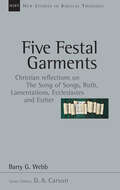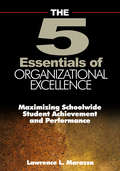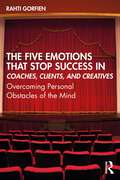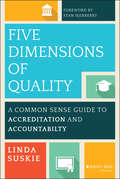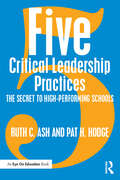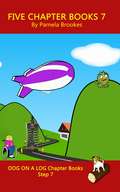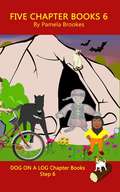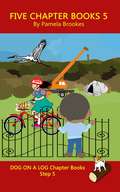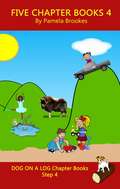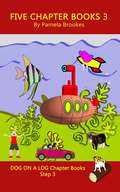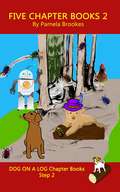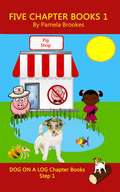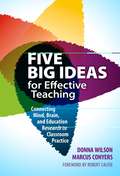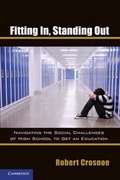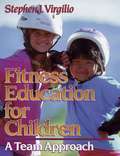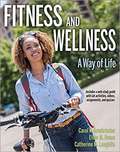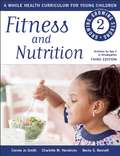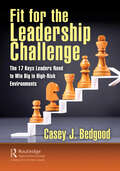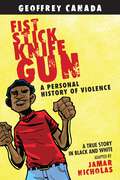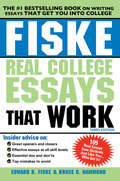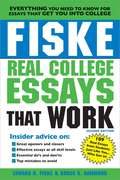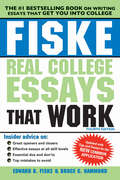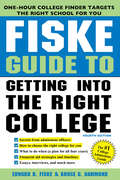- Table View
- List View
Five Graphic Music Analyses (Dover Books on Music)
by Heinrich SchenkerThe concepts of theorist Heinrich Schenker offer a unique method of structural analysis that differentiates between harmonic and contrapuntal functions of chords, emphasizing the relative significance of all tones in terms of motion and direction in the achievement of organic tonal unity.These sketches study the musical architecture of five compositions from three stylistic periods: two compositions by Bach -- " Ich bin's, ich sollte büssen" from the St. Matthew Passion and the Prelude No. 1 in C Major from Book I of The Well-Tempered Clavier; the development section from the first movement of Haydn's Sonata for Piano in E-Flat Major; and two ètudes by Chopin -- in F Major, Op. 10, No. 8, and in C Minor, Op. 10, No. 12. Each composition is analyzed in a series of sketches, with selective interpretations of chords, indications of voice leading, and other easily understood devices that demonstrate Schenker's theories and their expression.
Five Finger Discount
by Barthe DeclementsFifth grader Jerry Johnson is a PK, meaning a prisoner's kid. Grace Elliot is a PK, meaning a preacher's kid. Can these two become friends? Can Jerry resist the temptation of shoplifting?
Five Festal Garment: Christian Reflections on the Song of Songs, Ruth, Lamentations, Ecclesiastes and Esther (New Studies in Biblical Theology #No. 10)
by Barry G. WebbIn this New Studies in Biblical Theology volume, Barry Webb offers fresh and illuminating perspectives on the "festival garments" of love, kindness, suffering, vexation and deliverance through a study of The Song of Songs, Ruth, Lamentations, Ecclesiastes and Esther.
The Five Essentials of Organizational Excellence: Maximizing Schoolwide Student Achievement and Performance
by Dr Lawrence L. MarazzaThe essential strategies presented in this resource explore the necessity for building strong relationships among and between administrators, teachers, parents, and the community.
The Five Emotions That Stop Success in Coaches, Clients, and Creatives: Overcoming Personal Obstacles of the Mind
by Rahti GorfienThis book uniquely identifies the five key emotions that prevent clients reaching their full creative potential and provides coaches tools to help them overcome them, boosting their productivity as well as their ability to complete and promote their work and personal development. Accessible and personable, Rahti Gorfien interweaves stories from her personal life and private practice to alleviate the burden of blockages creatives generated by their own divergent thinking, unconscious conditioning, and memory. She takes each mindset in turn, shame, grandiosity, envy, boredom, and fear, and explores each emotion and how coaches can practically help clients overcome them to achieve creative freedom and success personally and professionally. Filled with practical exercises and coaching theory throughout, this book will equip coaches with tools to inspire confidence in their clients to share their work with the world, silencing negative inner voices and fulfilling their professional creative goals. This book is invaluable reading for coaches as well as artists, entrepreneurs, therapists, career advisors, social workers and those interested in finding methods of overcoming personal obstacles to making meaningful and authentic contributions through the freedom of their singular and passionate pursuits.
Five Dimensions of Quality
by Stanley O. Ikenberry Linda SuskieMeet calls for increased quality and understand accreditationexpectations Author Linda Suskie is internationally recognized for her workin higher education assessment, and she is a former vice presidentof a major regional accreditor. In Five Dimensions of Quality: ACommon Sense Guide to Accreditation and Accountability in HigherEducation she provides a simple, straightforward model forunderstanding and meeting the calls for increased quality in highereducation ever-present in today's culture. Whether your institutionis seeking accreditation or not, the five dimensions she outlineswill help you to identify ways to improve institutional quality anddemonstrate that quality to constituents.For those wading through the accreditation process, which hasbecome more difficult in recent years due to increasing regulationand pressure for greater accountability, Suskie offers expertguidance on understanding the underlying principles of theexpectations of accrediting bodies. Using the model presented here,which is much easier to understand than the sometimes complexresources provided by individual accrediting bodies, Americancolleges and universities can understand what they need to do toearn and maintain their regional accreditation as well as improveoverall institutional quality for their students. You'll be ableto:Identify ways to improve institutional qualityDemonstrate the quality of your institution to internal andexternal constituentsAvoid wasting time and energy on misguided institutionalprocesses to comply with accreditation requirementsBy focusing on why colleges and universities should takeparticular actions rather than only on what those actions shouldbe, Five Dimensions of Quality gives them the knowledge andstrategies to prepare for a successful review. It is an idealresource for leaders, accreditation committee members, and everyoneon campus.
Five Critical Leadership Practices: The Secret to High-Performing Schools
by Ruth C. Ash Pat H. HodgeWhat are the critical practices of leaders in high-performing schools? Based on extensive observations, interviews, and in-depth case studies of principals and superintendents who significantly increase student learning and achievement, this exciting new book provides novice and veteran school leaders with the five critical steps for effective school leadership: Focus on Direction Build a Powerful Organization Ensure Student-Focused Vision and Action Give Life to Data Lead Learning Rich with voices from highly effective leaders, this book provides an accessible, research-based framework for school improvement that is correlated with the field’s standards. The engaging case studies in this vital resource show the power of these five key critical practices to make a difference in the lives of students and transform schools to support learning for all.
Five Chapter Books 7: Decodable Books for Phonics Readers and Folks with a Dyslexic Learning Style (DOG ON A LOG Chapter Book Collection #Volume 7)
by Pamela BrookesFinally, a delightful book series that helps kids learn phonics rules step by step. Fun and engaging books designed for anyone learning to read with phonics, especially learners with dyslexia. Start anywhere in the series, according to your child's reading level. <P><P>To see if this book is the correct level for your child, you can use the "Look Inside" feature. <P><P>This collection is the five books in Step 7 of the DOG ON A LOG Chapter book series. <P><P>The books are:</br> --Quest For A Grump Grunt Chapter Book</br> --The Blimp Chapter Book</br> --The Spring In The Lane Chapter Book</br> --Stamp For A Note Chapter Book</br> --Stripes And Splats Chapter Book <P><P>Individual books can also be purchased separately. <P><P>Sight Words: a, are, be, does, go, goes, has, he, her, his, into, is, like, my, of, OK, says, see, she, the, they, to, want, you <P><P>Each book has about 1,350 to 2,640 total words <P><P>These are Step 7 Chapter books. <P><P>The DOG ON A LOG Books series are for phonics readers and folks with a dyslexic learning style. They are Decodable books which means a learner who has been taught the phonics rules and the limited sight words in that book can sound them out and read them. They are systematic because one Step of books follows another. The words used reflect the inclusion of 1 to 3 new phonics rules in each Step. Each Step of books builds on the skills practiced in the prior Steps. There are five books at each Step. <P><P>The chapter books are written in a chapter format with one picture in most chapters. They are longer, have more detail, and sometimes offer more complexity than the Let's GO! Books. They're great for practicing known and newly introduced phonics rules. They're also just fun reading. <P><P>DOG ON A LOG Let's GO! Books are shorter versions of DOG ON A LOG Chapter books. Let's GO! books tell the same stories with about 8 pictures and only a few sentences per page. They're perfect as an introduction to the new phonics rules or simply for fun reading for younger kids. <P><P>Most kids who read DOG ON A LOG Books are over-the-moon-proud that they can finally read abook without so much frustration. This builds confidence in new and struggling readers. Their parents are excited that, along with reading sight words, their kids can decode every word on every page. With each progressing Step the readers gain more confidence as the vocabulary, grammar, and stories become more complex and they see their skills and abilities growing with the books. <P><P>DOG ON A LOG Phonics Progression <P><P>Step 1</br> *Consonants, primary sounds</br> *Short vowels</br> *Digraphs: ch, sh, th, wh, ck</br> *2 and 3 sound words</br> *Possessive 's <P><P>Step 2</br> *Bonus letters (f, l, s, z after short vowel)</br> *"all"</br> *-s suffix <P><P>Step 3</br> *ang, ing, ong, ung, ank, ink, onk, unk <P><P>Step 4</br> *Consonant Blends to make 4 sound words</br> *3 and 4 sound words ending in -lk, -sk <P><P>Step 5</br> *Digraph blends -nch to make 3 and 4 sound words</br> *Silent e, including "-ke" <P><P>Step 6</br> *ild, old, olt, ind, ost</br> <P><P>Step 7</br> *5 sounds in a closed syllable word plus suffix -s (crunch, slumps)</br> *3 letter blends and up to 6 sounds in a closed syllable word (script, spring) <P><P>Step 8</br> *Two syllable words with 2 closed syllables, not blends (sunset, chicken, unlock)
Five Chapter Books 6: Decodable Books for Phonics Readers and Dyslexia/Dyslexic Learners (DOG ON A LOG Chapter Books #Volume 6)
by Pamela BrookesDecodable Chapter Books for Phonics Readers and folks with a Dyslexic Learning Style. <P><P>This collection is the five books in Step 6 of the DOG ON A LOG Chapter book series. <P><P>The books are: <P><P>The Colt </br> The Gold Bolt </br> Hide In The Blinds </br> The Stone Child </br> Tolt The Kind Cat <P><P>Sight Words: </br> a, are, as, be, come, comes, could, do, does, for, from, go, goes, has, have, he, her, here, his, I, into, is, me, Ms., my, no, of, OK, onto, or, pull, pulls, push, put, puts, said, say, says, see, sees, she, should, so, some, talk, talks, the, their, there, they, to, walk, walks, want, wants, was, we, what, where, would, you, your, yours <P><P>Each book has about 1,390 to 2,000 total words <P><P>These are Step 6 Chapter books. <P><P>The DOG ON A LOG Books series are for phonics readers and folks with a dyslexic learning style. The words used reflect the inclusion of 1 to 3 new phonics rules in each step. There are five books at each step. <P><P>The chapter books are written in a chapter format with one picture in most chapters. They are longer, have more detail, and sometimes offer more complexity than the Let’s GO! Books. They’re great for practicing known and new phonics rules. They’re also just fun reading. <P><P>DOG ON A LOG Let’s GO! Books are shorter versions of DOG ON A LOG Chapter books. Let’s GO! books tell the same stories with about 8 pictures and only a few sentences per page. They’re perfect as an introduction to the new phonics rules or simply for fun reading for younger kids. <P><P>DOG ON A LOG Phonics Progression <P><P>Step 1: Consonants, primary sounds Short vowels Digraphs: ch, sh, th, wh, ck 2 and 3 sound words Possessive ‘s <P><P>Step 2: Bonus letters (f, l, s, z after short vowel) “all” –s suffix <P><P>Step 3: ang, ing, ong, ung, ank, ink, onk, unk <P><P>Step 4: Consonant Blends to make 4 sound words 3 and 4 sound words ending in –lk, -sk <P><P>Step 5: Digraph blends –nch to make 3 and 4 sound words Silent e, including "-ke" <P><P>Step 6: ild, old, olt, ind, ost <P><P>Step 7: 5 sounds in a closed syllable word plus suffix -s (crunch, slumps) 3 letter blends and up to 6 sounds in a closed syllable word (script, spring) <P><P>Step 8: Two syllable words with 2 closed syllables, not blends (sunset, chicken, unfit) <P><P>WATCH FOR MORE STEPS AND BOOKS COMING SOON <P><P>For information on upcoming books see dogonalogbooks.com or visit our Facebook page.
Five Chapter Books 5: Decodable Books for Phonics Readers and Dyslexia/Dyslexic Learners (DOG ON A LOG Chapter Book Collections #Volume 5)
by Pamela BrookesDecodable Chapter Books for Phonics Readers and folks with a Dyslexic Learning Style. <P><P>This collection is the five books in Step 5 of the DOG ON A LOG Chapter book series. <P><P>The books are: <P><P>Bake A Cake</br> The Crane At The Cave</br> Ride A Bike</br> Crane Or Crane?</br> The Swing Gate <P><P>Individual books can also be purchased separately. <P><P>Sight Words: </br> a, are, as, be, come, comes, could, do, does, egg, eggs, for, from, go, goes, has, have, he, her, here, his, I, into, is, me, my, of, OK, or, pull, pulls, put, puts, said, say, says, see, sees, she, should, talk, the, their, there, they, to, walk, walks, want, wants, was, we, what, where, would, you, your <P><P>Each book has about 1,000 to 1,190 total words <P><P>These are Step 5 Chapter books. <P><P>The DOG ON A LOG Books series are for phonics readers and folks with a dyslexic learning style. The words used reflect the inclusion of 1 to 3 new phonics rules in each step. There are five books at each step. <P><P>The chapter books are written in a chapter format with one picture in most chapters. They are longer, have more detail, and sometimes offer more complexity than the Let’s GO! Books. They’re great for practicing known and new phonics rules. They’re also just fun reading. <P><P>DOG ON A LOG Let’s GO! Books are shorter versions of DOG ON A LOG Chapter books. Let’s GO! books tell the same stories with about 8 pictures and only a few sentences per page. They’re perfect as an introduction to the new phonics rules or simply for fun reading for younger kids. <P><P>DOG ON A LOG Phonics Progression <P><P>Step 1: Consonants, primary sounds Short vowels Digraphs: ch, sh, th, wh, ck 2 and 3 sound words Possessive ‘s <P><P>Step 2: Bonus letters (f, l, s, z after short vowel) “all” –s suffix <P><P>Step 3: ang, ing, ong, ung, ank, ink, onk, unk <P><P>Step 4: Consonant Blends to make 4 sound words 3 and 4 sound words ending in –lk, -sk <P><P>Step 5: Digraph blends –nch to make 3 and 4 sound words Silent e, including "-ke" <P><P>Step 6: ild, old, olt, ind, ost <P><P>Step 7: 5 sounds in a closed syllable word plus suffix -s (crunch, slumps) 3 letter blends and up to 6 sounds in a closed syllable word (script, spring) <P><P>Step 8: Two syllable words with 2 closed syllables, not blends (sunset, chicken, unfit) <P><P>WATCH FOR MORE STEPS AND BOOKS COMING SOON <P><P>For information on upcoming books see dogonalogbooks.com or visit our Facebook page.
Five Chapter Books 4: Decodable Books for Phonics Readers and Dyslexia/Dyslexic Learners (DOG ON A LOG Book Collections #Volume 4)
by Pamela Brookes<P><P>Decodable Chapter Books for Phonics Readers and folks with a Dyslexic Learning Style. <P><P>This collection is the five books in Step 4 of the DOG ON A LOG Chapter book series. <P><P>The books are: <P><P>The Push Truck</br> The Sand Hill</br> Lil Tilt And Mr. Ling</br> Musk Ox In The Tub</br> Trip To The Pond <P><P>Individual books can also be purchased separately. <P><P>Sight Words: </br> a, are, as, be, could, do, does, for, from, go, goes, has, have, he, her, here, his, I, into, is, like, likes, me, Mr., my, of, OK, or, push puts, said, saw. say, says, see, sees, she, should, the, there, they, to, want, wants, was, we, what, where, would, you, your <P><P>Each book has about 700 to 1,130 total words <P><P>These are Step 4 Chapter books. <P><P>The DOG ON A LOG Books series are for phonics readers and folks with a dyslexic learning style. The words used reflect the inclusion of 1 to 3 new phonics rules in each step. There are five books at each step. <P><P>The chapter books are written in a chapter format with one picture in most chapters. They are longer, have more detail, and sometimes offer more complexity than the Let’s GO! Books. They’re great for practicing known and new phonics rules. They’re also just fun reading. <P><P>DOG ON A LOG Let’s GO! Books are shorter versions of DOG ON A LOG Chapter books. Let’s GO! books tell the same stories with about 8 pictures and only a few sentences per page. They’re perfect as an introduction to the new phonics rules or simply for fun reading for younger kids. <P><P>DOG ON A LOG Phonics Progression <P><P>Step 1: Consonants, primary sounds Short vowels Digraphs: ch, sh, th, wh, ck 2 and 3 sound words Possessive ‘s <P><P>Step 2: Bonus letters (f, l, s, z after short vowel) “all” –s suffix <P><P>Step 3: ang, ing, ong, ung, ank, ink, onk, unk <P><P>Step 4: Consonant Blends to make 4 sound words 3 and 4 sound words ending in –lk, -sk <P><P>Step 5: Digraph blends –nch to make 3 and 4 sound words Silent e, including "-ke" <P><P>Step 6: ild, old, olt, ind, ost <P><P>Step 7: 5 sounds in a closed syllable word plus suffix -s (crunch, slumps) 3 letter blends and up to 6 sounds in a closed syllable word (script, spring) <P><P>Step 8: Two syllable words with 2 closed syllables, not blends (sunset, chicken, unfit) <P><P>WATCH FOR MORE STEPS AND BOOKS COMING SOON <P><P>For information on upcoming books see dogonalogbooks.com or visit our Facebook page.
Five Chapter Books 3: Decodable Books for Phonics Readers and Dyslexia/Dyslexic Learners (DOG ON A LOG Book Collections #Volume 3)
by Pamela BrookesDecodable Chapter Books for Phonics Readers and folks with a Dyslexic Learning Style <P><P>This collection is the five books in Step 3 of the DOG ON A LOG Chapter book series. <P><P>The books are: <P><P>Mr. Bing Has Hen Dots</br> The Junk Lot Cat</br> Bonk Punk Hot Rod</br> The Ship With Wings</br> The Sub In The Fish Tank <P><P>Individual books can also be purchased separately. <P><P>Sight Words: </br> a, are, as, be, could, do, does, for, from, go, goes, has, have, he, her, here, his, I, into, is, like, likes, me, Mr., Mrs., my, no, of, OK, or, put, puts, said, say, says, see, sees, she, should, the, their, there, they, to, want, wants, was, we, what, where, would, you, your <P><P>Each book has about 960 to 1,170 total words <P><P>These are Step 3 Chapter books. <P><P>The DOG ON A LOG Books series are for phonics readers and folks with a dyslexic learning style. The words used reflect the inclusion of 1 to 3 new phonics rules in each step. There are five books at each step. <P><P>The chapter books are written in a chapter format with one picture in most chapters. They are longer, have more detail, and sometimes offer more complexity than the Let’s GO! Books. They’re great for practicing known and new phonics rules. They’re also just fun reading. <P><P>DOG ON A LOG Let’s GO! Books are shorter versions of DOG ON A LOG Chapter books. Let’s GO! books tell the same stories with about 8 pictures and only a few sentences per page. They’re perfect as an introduction to the new phonics rules or simply for fun reading for younger kids. <P><P>DOG ON A LOG Phonics Progression <P><P>Step 1: Consonants, primary sounds Short vowels Digraphs: ch, sh, th, wh, ck 2 and 3 sound words Possessive ‘s <P><P>Step 2: Bonus letters (f, l, s, z after short vowel) “all” –s suffix <P><P>Step 3: ang, ing, ong, ung, ank, ink, onk, unk <P><P>Step 4: Consonant Blends to make 4 sound words 3 and 4 sound words ending in –lk, -sk <P><P>Step 5: Digraph blends –nch to make 3 and 4 sound words Silent e, including "-ke" <P><P>Step 6: ild, old, olt, ind, ost <P><P>Step 7: 5 sounds in a closed syllable word plus suffix -s (crunch, slumps) 3 letter blends and up to 6 sounds in a closed syllable word (script, spring) <P><P>Step 8: Two syllable words with 2 closed syllables, not blends (sunset, chicken, unfit) <P><P>WATCH FOR MORE STEPS AND BOOKS COMING SOON <P><P>For information on upcoming books see dogonalogbooks.com or visit our Facebook page.
Five Chapter Books 2: Decodable Books for Phonics Readers and Dyslexia/Dyslexic Learners (DOG ON A LOG Chapter Book Collections #Volume 2)
by Pamela BrookesDecodable Chapter Books for Phonics Readers and folks with a Dyslexic Learning Style. <P><P>This collection is the five books in Step 2 of the DOG ON A LOG Chapter book series. <P><P>The books are: <P><P>Mud On The Path</br> The Red Hen</br> The Hat And Bug Shop</br> Babs The ‘Bot</br> The Cub <P><P>Individual books can also be purchased separately. <P><P>Sight Words: </br> a, are, be, could, do, does, eggs, for, from, go, goes, has, have, he, her, here, his, I, into, is, like, likes, me, my, nest, of, OK, onto, or, puts, said, say, says, see, sees, she, should, the, they, to, want, wants, was, we, what, when, would, you, your <P><P>Each book has about 550 to 1,000 total words <P><P>These are Step 2 Chapter books. <P><P>The DOG ON A LOG Books series are for phonics readers and folks with a dyslexic learning style. The words used reflect the inclusion of 1 to 3 new phonics rules in each step. There are five books at each step. <P><P>The chapter books are written in a chapter format with one picture in most chapters. They are longer, have more detail, and sometimes offer more complexity than the Let’s GO! Books. They’re great for practicing known and new phonics rules. They’re also just fun reading. <P><P>DOG ON A LOG Let’s GO! Books are shorter versions of DOG ON A LOG Chapter books. Let’s GO! books tell the same stories with about 8 pictures and only a few sentences per page. They’re perfect as an introduction to the new phonics rules or simply for fun reading for younger kids. <P><P>DOG ON A LOG Phonics Progression <P><P>Step 1: Consonants, primary sounds Short vowels Digraphs: ch, sh, th, wh, ck 2 and 3 sound words Possessive ‘s <P><P>Step 2: Bonus letters (f, l, s, z after short vowel) “all” –s suffix <P><P>Step 3: ang, ing, ong, ung, ank, ink, onk, unk <P><P>Step 4: Consonant Blends to make 4 sound words 3 and 4 sound words ending in –lk, -sk <P><P>Step 5: Digraph blends –nch to make 3 and 4 sound words Silent e, including "-ke" <P><P>Step 6: ild, old, olt, ind, ost <P><P>Step 7: 5 sounds in a closed syllable word plus suffix -s (crunch, slumps) 3 letter blends and up to 6 sounds in a closed syllable word (script, spring) <P><P>Step 8: Two syllable words with 2 closed syllables, not blends (sunset, chicken, unfit) <P><P>WATCH FOR MORE STEPS AND BOOKS COMING SOON <P><P>For information on upcoming books see dogonalogbooks.com or visit our Facebook page.
Five Chapter Books 1: Decodable Books for Phonics Readers and Dyslexia/Dyslexic Learners (DOG ON A LOG Chapter Book Collection #Volume 1)
by Pamela BrookesDecodable Chapter Books for Phonics Readers and folks with a Dyslexic Learning Style <P><P>This collection is the five books in Step 1 of the DOG ON A LOG Chapter book series. <P><P>The books are: The Dog On The Log</br> The Pig Hat</br> Chad The Cat</br> Zip The Bug</br> The Fish and The Pig <P><P>Individual books can also be purchased separately. <P><P>Sight Words:</br> a, are, be, does, go, goes, has, he, her, his, into, is, like, my, of, OK, says, see, she, the, they, to, want, you <P><P>Each book has about 260 to 470 total words <P><P>These are Step 1 Chapter books. <P><P>The DOG ON A LOG Books series are for phonics readers and folks with a dyslexic learning style. The words used reflect the inclusion of 1 to 3 new phonics rules in each step. There are five books at each step. <P><P>The chapter books are written in a chapter format with one picture in most chapters. They are longer, have more detail, and sometimes offer more complexity than the Let’s GO! Books. They’re great for practicing known and new phonics rules. They’re also just fun reading. <P><P>DOG ON A LOG Let’s GO! Books are shorter versions of DOG ON A LOG Chapter books. Let’s GO! books tell the same stories with about 8 pictures and only a few sentences per page. They’re perfect as an introduction to the new phonics rules or simply for fun reading for younger kids. <P><P>DOG ON A LOG Phonics Progression <P><P>Step 1: Consonants, primary sounds Short vowels Digraphs: ch, sh, th, wh, ck 2 and 3 sound words Possessive ‘s <P><P>Step 2: Bonus letters (f, l, s, z after short vowel) “all” –s suffix <P><P>Step 3: ang, ing, ong, ung, ank, ink, onk, unk <P><P>Step 4: Consonant Blends to make 4 sound words 3 and 4 sound words ending in –lk, -sk <P><P>Step 5: Digraph blends –nch to make 3 and 4 sound words Silent e, including "-ke" <P><P>Step 6: ild, old, olt, ind, ost <P><P>Step 7: 5 sounds in a closed syllable word plus suffix -s (crunch, slumps) 3 letter blends and up to 6 sounds in a closed syllable word (script, spring) <P><P>Step 8: Two syllable words with 2 closed syllables, not blends (sunset, chicken, unfit) <P><P>WATCH FOR MORE STEPS AND BOOKS COMING SOON <P><P>For information on upcoming books see dogonalogbooks.com or visit our Facebook page.
Five Big Ideas for Effective Teaching: Connecting Mind, Brain, and Education Research to Classroom Practice
by Donna Wilson Marcus ConyersAs the 21st century ushers in the era of Common Core State Standards, the goal of teaching expands from a basic transmission of facts to the development of cognitive skills that equip students to achieve more of their unique potential. This seminal book focuses on five essential concepts from neuroeducation that should underlie all teaching decisions: (1) neuroplasticity, findings that the structure and function of the brain change in response to learning; (2) potential, the capacity for all students to make learning gains; (3) malleable intelligence, which stands in opposition to traditional views of fixed intellect; (4) the Body-Brain System, the role of physical fitness, healthy nutrition, and positive emotions in facilitating learning; and (5) metacognition, teaching students to "think about their thinking". To support classroom implemenation, these discussions include vignettes, examples, teaching strategies, reflective questions, and connections between brain-based learning principles and the Common Core. The text concludes by unmasking myths and misconceptions that may obscure these core concepts.
Fitting In, Standing Out
by Robert CrosnoeIn American high schools, teenagers must navigate complex youth cultures that often prize being 'real' while punishing difference. Adults may view such social turbulence as a timeless, ultimately harmless rite of passage, but changes in American society are intensifying this rite and allowing its effects to cascade into adulthood. Integrating national statistics with interviews and observations from a single school, this book explores this phenomenon. It makes the case that recent macro-level trends, such as economic restructuring and technological change, mean that the social dynamics of high school can disrupt educational trajectories after high school; it looks at teenagers who do not fit in socially at school - including many who are obese or gay - to illustrate this phenomenon; and it crafts recommendations for parents, teachers and policy-makers about how to protect teenagers in trouble. The result is a story of adolescence that hits home with anyone who remembers high school.
Fitness Education for Children
by Stephen J. VirgilioThe complete guide to developing a fitness education program at the elementary school level
Fitness And Wellness: A Way Of Life
by Carol K. Armbruster Ellen M. Evans Catherine M. Sherwood-LaughlinWith content targeted specifically toward the college-age population, Fitness and Wellness: A Way of Life With Web Study Guide presents evidence-based physical and mental health guidance to point students toward healthy choices that will develop into healthy lifestyles. Authors Carol K. Armbruster, Ellen M. Evans, and Catherine M. Laughlin have more than 80 years of combined health and wellness professional experience, the majority of which has focused on the college population. This enables them to present the material in a contemporary manner that is easily relatable and understood by students. Relevant information on topics such as cardiovascular exercise, strength training, stretching, nutrition, weight management, stress management, substance abuse and addiction, and sexual health will start students on the path to developing a healthy mind and body, which can lead to a better quality of life. Additionally, because Fitness and Wellness: A Way of Life emphasizes behavior modification to develop desired habits, students are armed with the tools they need to make healthy lifestyle changes—for both the present and future: • A web study guide offers 48 video clips and practical learning activities to provide real-life context to the material • Behavior Check sidebars help students integrate health and wellness concepts into their daily lives • Now and Later sidebars encourage students to consider how their actions today will affect them in the future • The Functional Movement Training section shows exercises to strengthen specific muscles and explains their importance for common activities • Infographics, evidence-based tables, and figures illustrate and reinforce key concepts so they are easy to understand The companion web study guide offers students the unique opportunity to engage directly with the content and practice the exercises and strategies presented. Lab activities for each chapter will guide students in completing individual assessments, setting goals, and identifying the pros and cons of modifying their behavior. Video clips of 48 exercises demonstrate proper exercise technique, and additional learning activities and quizzes gauge student comprehension of the content. In addition, students will benefit from learning aids such as key terms, a glossary, and review questions for each chapter. Instructors will benefit from an abundance of online ancillaries: a presentation package plus image bank, test package, chapter quizzes, and an instructor guide that includes chapter summaries, chapter objectives, class outlines, sample answers to the chapter review questions, and suggested class project activities. The primary goal of Fitness and Wellness: A Way of Life is to provide a personal, evidence-based tool to help students embrace living well. They will learn how to make healthy choices and positive behavior changes to lead and sustain healthier, happier, and more productive lives, now and in the future.
Fitness and Nutrition
by Connie Jo Smith Becky S. Bennett Charlotte M. HendricksDuring the preschool and kindergarten years, children begin spending more time engaging in physical activity and exploring new foods. Help children learn how to take care of their bodies as they build a foundation for healthy, active lives with this Fitness and Nutrition curriculum. Children will learn about motor development, fitness and physical activity, rest and relaxation, food choices and eating habits, and avoiding germs when eating.The curriculum includesOverviews of the six fitness and nutrition topicsSuggested interest area materials and supports for creating the learning environmentLearning objectives and vocabulary words to introduce and useSuggestions for evaluating children's understanding of each topicMore than 30 hands-on classroom activitiesFamily information and take-home activitiesThis book is part of the Growing, Growing Strong series, a whole-health curriculum for children age three though kindergarten. Together, the books provide a complete set of activities and resources to help you support children's growth and wellness.
Fit for the Leadership Challenge: The 17 Keys Leaders Need to Win Big in High-Risk Environments
by Casey J. BedgoodThe key to effective leadership is being fit for the challenge. Leadership is a perpetual boxing match in many respects in which preparation, stamina and skill are required. Only the strongest survive. Every decision and tollgate along the career journey is laden with risk. Those leaders who harness risk to their advantage will land the knockout punch in every fight. The only question is how many leaders will be fit enough for the challenge? The purpose of this book is to provide insight as to how risk impacts every aspect of leadership, including the mundane, routine and nonglamorous aspects of leadership. This is important because often the small things can easily turn into big disruptors. Moreover, the end goal is to equip leaders with a journey map and quick guide to win in high-risk environments. Change is the new normal and only constant in today’s world. As change increases, so will risk and its subsequent impacts on humanity. This includes leaders, organizations and customers. No one is exempt. In this book, readers learn how to: Determine which career battles to fight and which ones to avoid Prepare to fight the unavoidable challenges along the career journey Leverage risk to choose the right leaders for the team Leverage risk to invest time wisely and avoid wasting it Leverage risk to predict, identify and resolve leadership burnout Risk assess leadership credentials so only those that produce a return are added to the portfolio Risk assess performance outcomes so the path ahead is smooth sailing instead of a rough ride Leverage risk so high performance is a reality instead of a pipe dream Leverage risk to find the right leadership sponsor
Fist Stick Knife Gun: A Personal History of Violence
by Geoffrey CanadaLong before U.S. News and World Report named him one of America's Best Leaders and Oprah Winfrey called him "an angel from God," Geoffrey Canada was a small, vulnerable, scared boy growing up in the South Bronx. Canada's world was one where "sidewalk" boys learned the codes of the block and were ranked through the rituals of fist, stick, and knife. Then the streets changed, and the stakes got even higher. In this candid and riveting memoir, Canada relives a childhood in which violence stalked every street corner. "If you wonder how a fourteen-year-old can shoot another child his own age in the head and then go home to dinner," Canada writes, "you need to know you don't get there in a day, or week, or month. It takes years of preparation to be willing to commit murder, to be willing to kill or die for a corner, a color, or a leather jacket."
Fiske Real College Essays that Work 3E
by Edward B. Fiske Bruce G. HammondFrom the most trusted name in college admission resources comes the first application–essay book designed for those who need it most–bright students who aren't natural writers. By providing more than 100 real sample essays, college experts Edward Fiske and Bruce Hammond give students an all–inclusive guide to writing an application essay that will open the door to the college of their choice. Includes samples written with all degrees of proficiency and describes how to edit an essay, from initial draft to final submission.
Fiske Real College Essays That Work
by Edward B. Fiske Bruce G. HammondThe #1 book on college admissions essays, completely updated and revised From the most trusted name in college admissions, Fiske Real College Essays That Work is the first application essay book designed for those who need it most: bright students who aren't natural writers. College experts Edward Fiske and Bruce Hammond offer readers the best, most student-tailored advice on how to choose their topic and write their essay. Students can learn by example with more than 100 real sample essays, chosen from all degrees of writing proficiency, including 20 brand-new essays from students who got into the most up-and-coming, in-demand schools. Examples are also given to show how an essay is edited from initial to final draft. Fiske and Hammond give students an all-inclusive guide to writing an application essay that will open the door to the college of their dreams.
Fiske Real College Essays That Work
by Bruce Hammond Edward FiskeTop College Essays That Show You What Works1. Take the stress out of writing your essays!Every fall, thousands of aspiring students just like you spend hours staring at a computer screen, searching for a clever opening line or life-changing experience. It doesn't have to be that hard--we'll help you push past writer's block and find a topic that works for you!2. Let your personality shine through!A good essay does not need to be a literary masterpiece or a scholarly treatise worthy of James Joyce. The best essays come from high school students just being themselves. We'll teach you how to showcase yourself--and all the depth, with, charm, and quirkiness you bring to your daily life.3. Submit an essay that will get you in!College admissions experts Edward B. Fiske and Bruce G. Hammond give you all the advice you need for an essay that will open the door to the college of your choice. You'll find effective examples from real applicants--of all skill levels--and learn how to successfully bring your essay from initial draft to final submission.Real essays on these topics and more: Athletics The Arts Racial and Cultural Differences Humor Family Personal Growth Travel
Fiske Guide to Getting into the Right College
by Edward B. Fiske Bruce G. HammondGet accepted to the college that's right for you. Everyone has their own idea of the perfect college. The Fiske Guide to Getting into the Right College is the only admissions guide that starts with an in-depth assessment of your priorities, then takes you step-by-step through the process of applying to the schools you actually want to get into. The #1 expert on America's colleges will show you how to:Choose the right kind of school for you, Filter out the hype, Earn the test scores colleges want to see, Write authentic essays (even if you're not a great writer, Submit an application that shows off your best features, Ask the right questions during campus visits, Know how admissions officers rank candidates, Get off the waiting list and get accepted, and Attract and even negotiate the best financial aid package. The most trusted resource for helping students get into the schools of their choice. Edward B. Fiske served for seventeen years as education editor of the New York Times, during which time he realized that college-bound students and their families needed better information on which to base their educational choices. He writes the bestselling annual Fiske Guide to Colleges to help them. Bruce G. Hammond has devoted much of his time to counseling for college. He served as managing editor of the Fiske Guide to Colleges and is director of college counseling at Dipont Education Management. He has been quoted in numerous publications, including the New York Times, the Wall Street Journal,and U. S. News & World Report.


